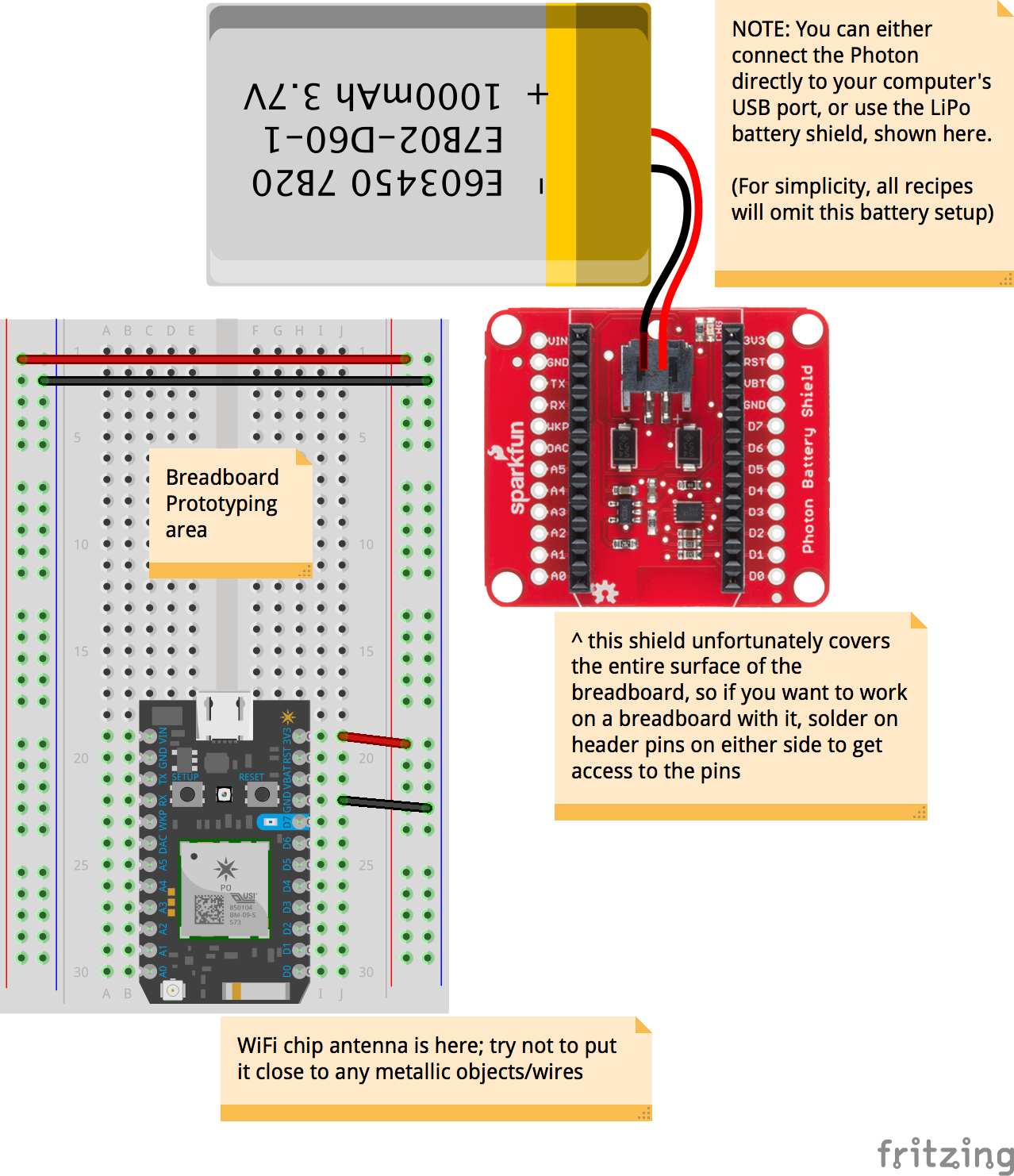1
2
3
4
5
6
7
8
9
10
11
12
13
14
15
16
17
18
19
20
21
22
23
24
25
26
27
28
29
30
31
32
33
34
35
36
37
38
39
40
41
42
43
44
45
46
47
48
49
50
51
52
53
54
55
56
57
58
59
60
61
62
63
64
65
66
67
68
69
70
71
72
73
74
75
76
77
78
79
80
81
82
83
84
85
86
87
88
89
90
91
92
93
94
95
96
97
98
99
|
// This #include statement was automatically added by the Particle IDE.
#include <SparkFunMAX17043.h>
// how long between each log update? feel free to change this value,
// but this must not be anything less than 1000 milliseconds!
#define INTERVAL_BETWEEN_LOGS 5000
// initialise the timer
Timer dataTimer(INTERVAL_BETWEEN_LOGS, doDataUpdate);
// Battery monitoring
float voltage = 0; // Variable to keep track of LiPo voltage
float soc = 0; // Variable to keep track of LiPo state-of-charge (SOC)
bool alert; // Variable to keep track of whether alert has been triggered
// code in this setup function runs just once, when Photon is powered up or reset
void setup() {
Serial.begin(9600); // Open a connection via the Serial port / USB cable – useful for debugging
delay(5000); // Common practice to allow board to 'settle' after connecting online
dataTimer.start();
pinMode(D0, INPUT_PULLDOWN); // tell the Photon we're using D0 as an INPUT (pulldown resistor enabled)
pinMode(D1, INPUT_PULLDOWN); // tell the Photon we're using D1 as an INPUT (pulldown resistor enabled)
// if you're adding more digital pins as INPUT, add lines similar to the above accordingly.
// note: analogue pins do not need to be initialised as they are INPUTs by default
// BATTERY GAUGE CODE STARTS HERE:
// -------------------------------
// To read the values from a browser, go to:
// http://api.particle.io/v1/devices/{DEVICE_ID}/{VARIABLE}?access_token={ACCESS_TOKEN}
// Set up Particle variables (voltage, soc, and alert):
Particle.variable("voltage", voltage);
Particle.variable("soc", soc);
Particle.variable("alert", alert);
// Set up the MAX17043 LiPo fuel gauge:
lipo.begin(); // Initialize the MAX17043 LiPo fuel gauge
// Quick start restarts the MAX17043 in hopes of getting a more accurate
// guess for the SOC.
lipo.quickStart();
// We can set an interrupt to alert when the battery SoC gets too low.
// We can alert at anywhere between 1% - 32%:
lipo.setThreshold(20); // Set alert threshold to 20%.
}
// code in this loop function runs forever, until you cut power!
// for the A/D blackbox, there is nothing to do in here because data updates are handled by our timer
void loop() {
}
// doDataUpdate runs every interval set in INTERVAL_BETWEEN_LOGS
void doDataUpdate() {
// IMPORTANT: to prevent server overload, the Particle cloud can only accept
// update rates of once per second, with the option to 'burst' 4 updates in a
// second (but then you'll get blocked for the next 4 seconds). 'Ration' your
// INTERVAL_BETWEEN_LOGS and the number of readings you are publishing; in our
// default example, we are frugally using just 1 publish, by concatenating
// all the data we want into a single publish statement
// first we save what we want to read into temporary variables first.
// feel free to add/remove these lines as you see fit in your application:
bool D0State = digitalRead(D0); // read a digital true/false state from D0
bool D1State = digitalRead(D1); // read a digital true/false state from D1
int A0State = analogRead(A0); // read an analogue range (0-4095) from A0
int A1State = analogRead(A1); // read an analogue range (0-4095) from A0
// now we form the concatenated string to put them all together. This String
// must NOT exceed 255 characters!
String output = "D0:" + String(D0State) + ",D1:" + String(D1State) +
",A0:" + String(A0State) + ",A1:" + String(A1State);
// prints this out the Serial port (coolterm) for us HUMANS to verify and
// debug; comment the next line if you don't want to see it in Coolterm
Serial.println(output);
// finally, send it out (and have sensored.mdit.space receive it):
Particle.publish("sensorData", output);
// BATTERY MONITORING
// lipo.getVoltage() returns a voltage value (e.g. 3.93)
voltage = lipo.getVoltage();
// lipo.getSOC() returns the estimated state of charge (e.g. 79%)
soc = lipo.getSOC();
// lipo.getAlert() returns a 0 or 1 (0=alert not triggered)
alert = lipo.getAlert();
String battStat = "V:" + String(voltage) + ",SOC:" + String(soc) + ",ALERT:" + alert;
Particle.publish("battStat", battStat);
}
|

